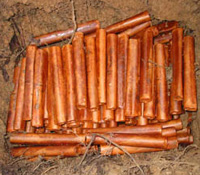THE
PURSUIT AND CAPTURE OF ERIC RUDOLPH
Part 1 of an Interview with FBI Exec Chris Swecker
05/16/05
 Between 1996 to
1998, bombs exploded four times in Atlanta and Birmingham, killing
two and injuring hundreds…and setting off what turned out to
be a five-year manhunt for the suspected bomber Eric Rudolph. Then,
on 5/31/03, police officer J.S. Postell found Rudolph rummaging through
trash at a rural North Carolina grocery and arrested him on the spot.
Last month, Rudolph pled guilty and told authorities where he’d
stashed an additional 250 pounds of dynamite.
Between 1996 to
1998, bombs exploded four times in Atlanta and Birmingham, killing
two and injuring hundreds…and setting off what turned out to
be a five-year manhunt for the suspected bomber Eric Rudolph. Then,
on 5/31/03, police officer J.S. Postell found Rudolph rummaging through
trash at a rural North Carolina grocery and arrested him on the spot.
Last month, Rudolph pled guilty and told authorities where he’d
stashed an additional 250 pounds of dynamite.
In this
first of a two-part interview, FBI executive Chris Swecker, who headed
our Charlotte office when the arrest was made, shares behind-the-scenes
information about the relentless pursuit and capture of the survivalist
bomber.
Why was the
Southeast Bomb Task Force so convinced that Rudolph was hiding in western
North Carolina?
Mr. Swecker: Because of his personal makeup and overall familiarity
with the area—and the fact that there were no credible sightings anywhere
else. A lot of people at the highest levels said, ‘He’s dead; he’s
gone.’ But three members of the task force in particular kept the focus
on western North Carolina. If not for them, the whole investigation might have
dwindled down to just one or two agents. They were adamant he was in the area,
absolutely adamant, in the face of a lot of skepticism. I think 90 percent
of the population had written off Rudolph as being out of the area, long gone,
or dead.
What was the
on-site strategy of the task force?
Mr. Swecker: They had a great plan because it actively involved local
law enforcement—keeping them up to speed on where the sightings were
and keeping in close contact. Also, even though there was so little to go on,
they had really done their homework. They got to know the geography; they’d
done a personality profile; they regularly contacted family members; they had
a whole cadre of scouts who were walking the forest area and reporting back
to us what they saw.
Did anybody
help Rudolph avoid detection?
Mr. Swecker: That’s what a lot of people think. But Rudolph
is such a loner that we strongly believed he simply wouldn’t have trusted
anybody. He had access to news; he had newspaper articles in his camp. He knew
he was being pursued. I don’t think he would have made himself vulnerable
to being compromised or betrayed by letting anyone know where he was.
Did the pursuit
keep him from carrying out more attacks?
Mr. Swecker: Absolutely. Rudolph admitted that he’d toyed with
going after the agents who were pursuing him. We know he buried at least four
caches of explosives in the area. One was right above the National Guard armory
where our command post was located. He claimed he made the decision not to
booby-trap our post. But I think he didn’t because we kept the pressure
on him, kept patrols going, kept a visible presence. He just couldn’t
get to his explosives and do what he would have liked to have done. That was
the primary reason we were there. We wanted to catch him, but we also wanted
to make sure he didn’t strike again. I’m convinced that the investment
of manpower we had during that time period saved lives.
Link: May
2003 Arrest Press Release
Above photo shows
some of the nitroglycerin dynamite hidden by Eric Rudolph and recovered
by the FBI and other authorities in April. We also found fully and
partially constructed bombs and remote control detonators.


